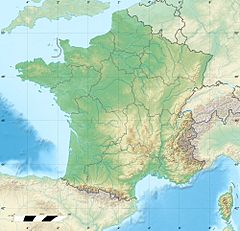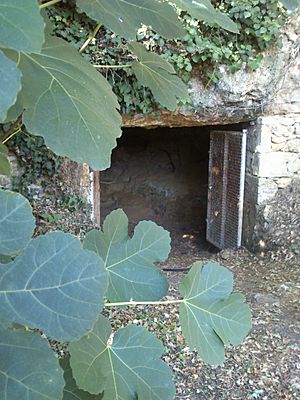La Marche (cave) facts for kids

La Marche Cave
|
|
| Location | Lussac-les-Châteaux |
|---|---|
| Region | department of Vienne, western France |
| Coordinates | 46°24′22″N 0°43′28.6″E / 46.40611°N 0.724611°E |
La Marche is a famous cave and archaeological site in western France. It's located in a place called Lussac-les-Châteaux. This site is special because of the amazing ancient art found there. In 1937, people discovered detailed carvings of humans and animals. These carvings might be as old as 15,000 years! However, some people have debated if these ancient artworks are real.
Contents
Where is La Marche Cave?
The La Marche cave is in western France, near the town of Lussac-les-Châteaux. It sits at the bottom of a small valley. A river called Petit Moulin flows nearby. The cave probably formed from the river tunneling underground.
France is home to many ancient cave art sites. Almost half of the 350 known Ice Age cave art sites in Europe are in France. Besides La Marche, other famous French caves with ancient art include Lascaux, Chauvet, and Rouffignac.
The artwork at La Marche comes from a time called the middle Magdalenian period. This means it was made about 14,000 to 15,000 years ago. La Marche was a great spot for early humans. It offered shelter and was well-preserved over time.
Discovering the Ancient Art
The ancient art in La Marche Cave was found by Léon Péricard in November 1937. He and his partner, Stephane Lwoff, spent five years studying these caves. They found carvings on more than 1,500 stone slabs!
In 1938, they shared their discovery with the French Prehistoric Society. They also published their findings in the Society's magazine. However, many people doubted if the art was real. They thought the paintings looked too much like modern art.
Lwoff also gave some incorrect information in his talks about the caves. This made people trust the findings even less. Because of this, the La Marche caves were not seen as important discoveries at first.
A French priest named Henri Breuil studied the caves again in 1938 and 1939. His results were similar to Péricard's. This helped more people believe that the paintings were authentic. After this, La Marche was not studied again for a long time.
In 2002, a scientist named Dr. Michael Rappenglueck from Munich University looked at Péricard's findings again. He believes Péricard's discoveries are real. He started a new, more detailed study of the caves.
Dr. Rappenglueck also thinks that many paintings were lost during Péricard's first digs. Péricard focused on the walls and might have damaged art on the cave floors. Dr. Rappenglueck hopes that studying the floors carefully might reveal more clues. This could help prove Péricard's original discovery.
What Was Found at La Marche?
When Léon Péricard explored La Marche, he found over 1,500 pieces of limestone. These stones had been carefully placed on the cave floor.
In recent years, a full list of all the finds has been made. Scientists have found and numbered 1,512 pieces. Of these, 386 were complete artworks. The carvings show many things, including animals like lions and bears. There are also 155 pictures of humans. These humans are shown wearing robes and boots, and each has a unique face.
Art Style
The detailed portraits found at La Marche are very different from other ancient cave paintings. Most older cave art used simple stick figures. But these portraits are more realistic and lifelike. The carvings are also more complex and detailed than art found at other sites.
Many figures are drawn on top of each other. Sometimes, a single figure is carved multiple times. This style made the carvings hard to understand when they were first found. It also made people doubt if they were real.
Human Figures
Péricard first found 69 human figures in the caves. There were 49 carvings of just heads and 18 of full bodies. In total, 50 were female, 12 were male, and 5 had an unknown gender. Later, 155 human figures were identified.
Péricard carefully studied the faces in the carvings. He looked at the eyes, ears, and nose. He also studied the shape of the skull, chin, and cheekbones. He noticed that each carving had different facial features. This suggests the artists were trying to show different, specific people. Artists used certain facial traits to identify a person, or even their gender.
The bodies in the La Marche carvings also have special features. Most of the body carvings are of women. Their bodies were often shaped like a diamond. They had small heads, large bellies (suggesting they were overweight), and small feet. Men were also carved with large bodies, but this was less common than for women.
Body shapes are very helpful for telling the gender of a figure. They show things like secondary sex characteristics. Many carvings also show people wearing hats, robes, and boots. This is different from what was usually thought about prehistoric people. It's possible that paintings of clothed humans in other caves were destroyed during studies.
Star Constellations
Dr. Michael Rappenglueck has also noticed small pits on the cave floor. These pits are arranged like certain star constellations. One group of pits looks like the Pleiades star cluster. This constellation has been found carved in much later caves, but rarely in very ancient ones.
Dr. Rappenglueck thinks these pits might have held animal fat and been lit like candles. If so, they could have been used to show the stars in the sky. He even suggests this site could be where candlelit festivals, like those in the Far East that celebrate the Pleiades, first began.
See also
- Art of the Upper Paleolithic
- List of Stone Age art




